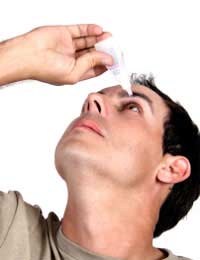What Causes Dry Eye?

Dry eye occurs when there is not enough fluid in the eye and the eye becomes irritated. The term dry eye can apply to a number of conditions where there is a lack of fluid in the eye.
The eye continually produces tears to keep it lubricated but when the eye stops producing tears it causes a stinging or burning sensation and it can feel as if there is a foreign object in the eye. Blinking can be painful in severe cases.
It is important to have sufficient and good quality tears in the eye as they contain antibiotics which are necessary to fight any infection in the eye. Blinking spreads the fluid over the eyes and it then drains away through tear ducts. When the tear glands do not produce enough fluid or the fluid is not of good quality, dry eye occurs. Tears need to be of a good quality to prevent them evaporating too quickly. Dry eye can also develop when the tears drain away too quickly.
The condition is more common amongst women but it can happen to anyone and is more likely to occur in older people. It often goes unnoticed as many people think it is just part of the ageing process. It is not usually picked up until another condition such as poor tear drainage develops that it is diagnosed.
The medical term for the condition is Keratisis but it can also be referred to as Sicca Keratoconjunctivitis Sicca (KCS) or Xerophthalmia depending on the type of dry eye.
Causes of Dry Eye
Dry eye can be made worse by a number of factors. These can include central heating, air conditioning and using computers for a long period of time. Using a humidifier can help to reduce the affects of central heating and not sitting too close to direct heat such as gas or electric fires will also help. Hormonal changes in women as a result of pregnancy, lactation, oral contraceptives, menstruation, and post-menopause can cause dry eye conditions. Conditions such as arthritis, asthma, thyroid abnormalities can also lead to dry eye.Treatments for Dry Eye
There are several treatments which can relieve the symptoms and reduce any discomfort. Initially just blinking consciously a lot when you are doing close up work will help the problem. Lubricating eye drops will help to soothe the irritation and provide immediate relief. However some eye drops contain a preservative which some people may be allergic to. If they do cause an irritation then you can get a prescription from the hospital pharmacy for a preservative free medication. There are also lubricant ointments available which are particularly helpful at night.Special plugs can block the tear duct to reduce excessive tear drainage. These collagen plugs work by closing the tear duct allowing more fluid to be retained in the eye. This is a temporary measure as the plugs dissolve in about a week. If symptoms improve with the plugs your eye specialist may advise a longer term solution. Silicone plugs are used for permanent treatment of some dry eye conditions. These can easily be inserted and the procedure is not painful. Although it is a permanent treatment they can be removed if the cause of the dry eye condition improves later in life. In severe cases a surgical procedure can block the tear ducts.
- Rosacea in the Eye
- Is a Vitreous Haemorrhage Serious?
- My Mum Has Macular Degeneration
- What is Vitrectomy Surgery?
- Why Do Eyelids Twitch?
- What is Graves' Ophthalmology?
- Retinal Vein Occlusion
- Retinitis Pigmentosa
- Corneal Disease
- Corneal Ulcers
- Nystagmus
- Flashes and Floaters
- Keratoconus
- Double Vision
- Eye Infections
- Diabetes and Eyes
- Hay Fever and Allergies


Re: Contact Lens Trials Explained
Hi Please could you put me in touch with your wholesale/distribution department. Which countries do you currently…
Re: What is Vitrectomy Surgery?
I had vitrectomy 4 weeks ago. The surgery was not well done as apparently bleeding occurred. The hole did not close despite having…
Re: Glasses or Contacts?
I need a eye exam and new glasses it's been since 2013/ I have no income I lost my boyfriend last September and I've been homeless ever…
Re: Eyewear for the Partially Sighted
This extract from your text is not clear and the grammar is poor- and the letters in the validation box are mixed…
Re: Eye Cancer Symptoms
I have yellow in both eyes lools like 2 dots. But looks like its makin the white part of my eye yellow whats wrong with me
Re: Are my Glasses Affecting my Eyes?
Hi, Please can anyone give advice on wearing varifocals. After a short while I develop a severe ache in my left eye and…
Re: Are my Glasses Affecting my Eyes?
On wearing my new varifocals, I am finding that my left eyeball hurts so much it feels like it will explode after 15…
Re: What is the Cause of my Itchy Eye?
I have One and only One itchy eye that has been going on 24/7 for 5 weeks.Eye is not swollen vision not affected. Eye doc…
Re: Contact Lens Trials Explained
Hi, We wanted to get in touch with you to increase traffic on your website. Please reply to this email so we can send you free…
Re: What Are Photoreceptors?
I have a 10 year old grandson who was diagnosed at apx 2 with cone and rod dystrophy eye disease. Please help with any treatment…